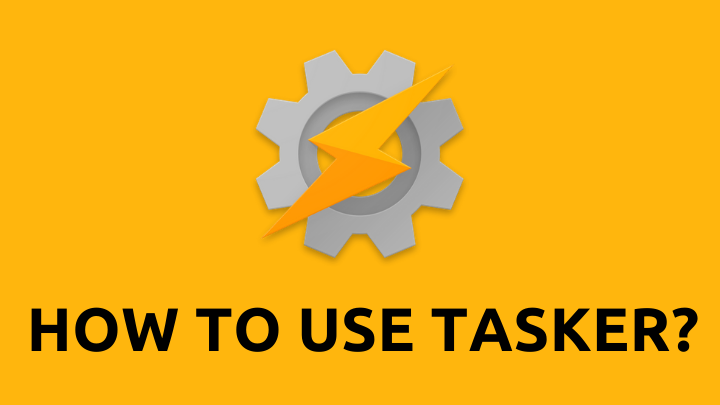Learn about using Tasker.

On the edge of the Fourth Industrial Revolution or Industry 4.0. The Internet and its significant others named the Internet of Things and the Internet of systems are changing the human world’s dynamics with dramatic shifts. The 4th Industrial Revolution is all about making the experience of the Internet-accessible, affordable, better, and efficient for all.
TASKER is one of them. It takes care of our events, interactions, tasks, digital decluttering, and so much of other trivial activities. Tasker profiles are incredible and awesome. Pop over here to know more.
João Dias first developed Tasker, previously Crafty Apps EU, in 2010 as an idea of enhancing user’s experience of automation and making life hassle-free. Available on Google Playstore for $3.60 or Rs.270 approx. Apart from a variety of Pre-Medalled Plugins, the user can also use third-party plugins to customize the tasks.
Before using the app, the user needs to understand the different terminology used in the app. The app concentrates on the “actions” that need to happen to get the user’s phone to a specific state. There are 200+ built-in actions. A “task” then refers to a multitude of actions. Hence, the tasks will be performed according to the actions of the user’s command.
- The user needs to set a task’s “context” to get the task to perform necessarily.
- The Profile is the collection of contexts and tasks.
- Variable refers to states that will change with time.
- The scene is a customized user interface.
- Project is the accumulation of profiles, variables, tasks, and scenes.
The first time the user opens the app, he/she will experience the app in a beginner’s version. They’ll see three tabs at the top of the page: Profiles, Tasks, and Scenes. They can switch to a more advanced model in the app’s preference.
A GUI (Graphical User Interface) comes with two major sections, “Tasks and Profiles.” The Profile Tab is used to create and set triggered tasks. The user customizes the triggers and their inputs. When the Profile is created, the user is to set the task, which will be configured in the tasks tab, so that the Trigger can execute the action.
There are six options available in the Profiles section of the Tasker app. All are described as follows.
1. Application:
First on the menu comes the Application category. When this option is selected, the user can use Pre Installed Plugins in android devices. Which is just one of the many reasons android phones are more flexible than iOS. The user can select one or more apps based on the task, i.e., scheduled to perform.
By default, whenever the selected apps open, it will perform the background tasks with the help of the Invert option.
Another alternative it allows comes in the form of “Activity,” a default option, which, when enabled, will cause the task to run whenever any screen within the Tasker app is opened. They usually use several options like Services and All as default options.
2. Day:
Following the application’s context comes the day option to help with day-to-day activities. After selecting this option, a calendar appears on the screen where the tasks can be registered to run on certain days or months. Options like Weekdays or Alternate days are also available the user can customize. Similarly, in months, the user can customize for certain months when the event like summer or winter or autumn holidays are scheduled.
3. Event:
It’s a friendly reminder for people prone to forgetfulness or dementia, where they can program to send important texts, emails, phone calls, or run errands. It is of great use to people with Tasker profiles. The event takes care of all the needs mentioned above, equipped with options like system category, device boot, sensors, etc. It acts as a Personal Assistant for the user when it reminds or performs the user’s tasks. It’s also handy for planning. Not having to obsess if or not all it takes the events care of to be reminded.
4. Location:
Working Hand in Hand with GPS (Global Positioning System) performs the more complex operations. To give an instance, it can tone up or tone down the volume according to the place where the user currently is. Location can be added manually or by clicking the current location feature that automatically detects the present site.
5. State:
This is quite similar to the event option but differs in time duration or situation. It’ll act when there’s a low battery if the user has programmed in such a task. A state change will trigger the task. It’s also well endowed with options based on the device’s Hardware, Software, and connectivity capabilities. The user can use a filter option to select the most suitable Trigger. Where the State Edit allows even more details and rules.
6. Time:
Last on the list of context is the time option. It’s usually used to set tasks based on different periods. Quite helpful when it comes to setting a sleep schedule so that the user doesn’t have to worry about whether he/she has set the alarm for the following day or not.
Much of our tensions will be relieved with apps like Tasker. Not having to worry about the obligations humans possess in this world, which is evolving at the rate of who knows. Having to keep up with such necessities is a burden the humankind will no longer have to bear. Of course, the technology still needs to evolve to use this app irrespective of their professions. It’s designed currently best suited for students, Teachers, Corporate Workers, and many more. It still hasn’t quite penetrated the sphere of different professions yet.
App Developers need to keep in mind the viewpoint of people from all walks of life. Suppose they can’t quite suffice it in one app. They can build others for different professions to use. Universal Usability is the future of technology.
